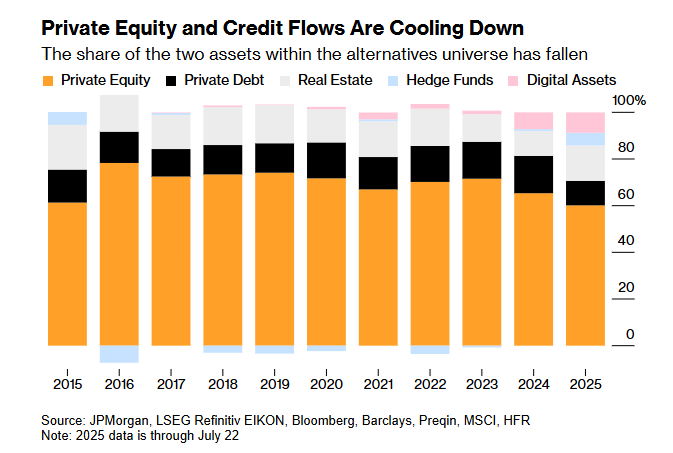BlackRock’s iShares Bitcoin Trust (IBIT) experienced a $292 million outflow on Monday, marking its largest since May, as Bitcoin recovered from weekend volatility and spot Bitcoin ETFs showed signs of cooling.
-
BlackRock’s IBIT outflowed $292.5 million amid Bitcoin’s weekend dip and partial recovery.
-
Spot Bitcoin ETFs in the US collectively sold off for the third consecutive day, with mixed flows across major funds.
-
Expert analysis highlights digital assets gaining market share in alternative investments despite private asset slowdowns.
BlackRock’s IBIT outflow signals Bitcoin volatility shifts; spot ETFs cool while digital assets gain market share. Stay informed with COINOTAG.
What caused BlackRock’s IBIT $292 million outflow amid Bitcoin’s recent volatility?
BlackRock’s iShares Bitcoin Trust (IBIT) recorded a $292.5 million outflow on Monday, its largest since May, triggered by Bitcoin’s weekend decline from its July 14 all-time high. Bitcoin fell 8.5% to $112,300 before recovering to $115,000, influencing investor sentiment and ETF flows.
How are US-listed spot Bitcoin ETFs performing during this period?
US-listed spot Bitcoin ETFs have experienced three consecutive days of aggregate outflows. Fidelity’s Wise Origin Bitcoin Fund (FBTC) saw approximately $40 million exit, Grayscale Bitcoin Trust (GBTC) lost $10 million, while Bitwise (BITB) attracted $18.7 million in inflows. Overall, Monday’s outflows were milder compared to Friday’s $812 million sell-off, indicating a potential stabilization near $112,000 support levels.

Why are digital assets gaining market share in alternative investments?
Despite a cooling private asset market, digital assets and hedge funds are accelerating inflows this year. According to Bloomberg ETF expert Eric Balchunas, digital assets have attracted $60 billion through July 22, following a record $85 billion last year. JPMorgan’s Nikolaos Panigirtzoglou notes this trend contrasts with weak fundraising in private equity and credit, highlighting digital assets as a fast-growing segment in alternatives.

How have Bitcoin ETFs impacted market volatility?
Since the launch of spot Bitcoin ETFs in January 2024, Bitcoin’s volatility has significantly decreased. The 90-day rolling volatility for BlackRock’s IBIT fund dropped below 40, down from over 60 at launch. This reduced volatility has minimized sharp drawdowns, attracting larger institutional investors and enhancing Bitcoin’s potential adoption as a currency, according to expert commentary.
| ETF | Monday Flow ($M) | Comparison to Friday ($M) |
|---|---|---|
| BlackRock IBIT | -292.5 | Less outflow than Friday’s $812M |
| Fidelity FBTC | -40 | Consistent outflows |
| Grayscale GBTC | -10 | Stable outflows |
| Bitwise BITB | +18.7 | Inflow amid overall outflows |
Frequently Asked Questions
What factors influenced BlackRock’s IBIT outflow in August 2025?
BlackRock’s IBIT outflow was influenced by Bitcoin’s weekend price drop from its July peak, triggering investor withdrawals despite a partial price recovery on Monday.
How do spot Bitcoin ETFs affect Bitcoin’s market stability?
Spot Bitcoin ETFs reduce volatility by offering regulated, accessible investment options, which help stabilize Bitcoin prices and attract larger institutional investors.
Key Takeaways
- BlackRock IBIT outflow: Largest since May at $292.5 million amid Bitcoin price volatility.
- Spot Bitcoin ETFs: Experienced three consecutive days of aggregate outflows with mixed fund performances.
- Digital assets growth: Gaining market share in alternatives, attracting $60 billion in inflows year-to-date.
- Volatility reduction: Bitcoin’s 90-day volatility dropped significantly post-ETF launches, aiding institutional adoption.
Conclusion
BlackRock’s IBIT outflow highlights the sensitivity of Bitcoin ETFs to market volatility, yet the broader digital asset sector continues to gain momentum within alternative investments. Reduced volatility from ETF adoption supports Bitcoin’s growing institutional appeal. Monitoring these trends is essential for investors navigating the evolving crypto landscape.
